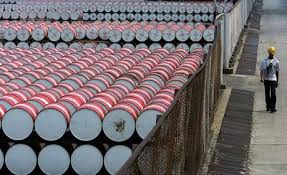 WTI and Brent futures were slightly higher during midday trade in Europe today, as the US posted weekly oil inventories readings. Meanwhile, natural gas futures orbited eight-month lows, ahead of the EIA weekly nat gas report on Thursday.
WTI and Brent futures were slightly higher during midday trade in Europe today, as the US posted weekly oil inventories readings. Meanwhile, natural gas futures orbited eight-month lows, ahead of the EIA weekly nat gas report on Thursday.
WTI for September delivery traded at $102.59 per barrel at 14:39 GMT in New York today, up 0.20%. Prices ranged from $101.79 to $102.73 per barrel. The contract dropped 0.46% on Tuesday, after adding 0.89% the previous session.
Meanwhile, Brent September futures stood at $107.73 per barrel, up 0.37%. Daily high and low were at $108.05 and $106.87 per barrel, respectively. Brent’s premium to WTI was at $5.14, after last session’s closing margin of $4.94. The European contract lost 0.33% yesterday, after adding 0.41% on Monday.
US oil inventories
The US Energy Information Administration (EIA) posted its weekly oil inventories report for the seven day through July 18 today. The log revealed a 3.969 million-barrel draw for commercial crude oil inventories, after the private American Petroleum Institute (API) had suggested a 0.555 million-barrel draw on Tuesday. A Bloomberg survey had projected a 2.9 million-barrel drop, while the Wall Street journal projected 2.5 million barrels drawn. The previous reading, for the week through July 11, showed crude inventories had dropped 7.5 million barrels.
Oil at Cushing, Oklahoma, the delivery point for the NYMEX contract and the largest hub in the US, was reported at 18.8 million barrels for a 1.5 million-barrel draw, after a further 0.6 million-barrel drop was logged for the previous week. Meanwhile, hubs at the Gulf Coast saw 0.9 million barrels drawn, after a 2.8 million drop was reported last week.
Domestic production of crude oil was little changed for a reading of 8.565 million barrels per day (bpd), after more minor changes over the pat month. Meanwhile, imports of crude were also little changed at 7.407 million bpd.
Gasoline inventories added 3.379 million barrels for the week through July 18, while the API had reported a 3.6 million-barrel increase. Distillate fuels stockpiles levels increased by 1.636 million barrels, while the API posted a 2.5 million-barrel gain on Tuesday.
Refinery utilization rate was unchanged at 93.8%, after an increase of more than 7% for the past month. Gasoline production this week was slightly higher at 9.788 million bpd, while distillates output averaged 5.206 million bpd, also logging a minor increase.
Natural gas
Front month natural gas futures, due in August, traded at $3.782 per million British thermal units (mBtu) at 14:07 GMT in New York today, up 0.27%. Prices ranged from a eight-month low of $3.755 to $3.817 per mBtu. The contract lost 2.00% on Tuesday, after a further 2.58% loss on Monday.
“The below-normal temperatures slated to remain fairly dominant in the eastern half of the U.S. will likely take a bite out of natural-gas demand,” analysts at WeatherBELL Analytics wrote in a research note, cited by the Wall Street journal.
NatGasWeather.com suggested an injection of 90-95 billion cubic feet (Bcf) will be reported tomorrow, which would be some 40 Bcf larger than the average gain for the week.
As weather cools, US residences and businesses turn off air cooling, dampening power demand. Power stations account for about 30% of US nat gas consumption and, naturally, power demand impacts natgas prices.
However, some analysts suggest that the slump in prices may allow some stations to shift from burning coal to utilizing natural gas, which could potentially support the blue fuel against further massive declines.
“Natural-gas demand in general is down because of the cool weather but the mix between natural gas and coal is shifting more toward natural gas,” Aaron Calder, market analyst at Gelber & Associates, said for the Wall Street Journal.
This winter was quite brutally cold for the US, resulting in a massive surge for heating demand. The most used fuel for heating in the US is natural gas, and the blue fuel, naturally, peaked to double current prices. Coal, however, is used primarily in industrial and power-station settings, and the soaring natgas prices induced only secondary coal rally, as some facilities switched to coal as a fuel. This created an imbalance between the fuels, which only needed the proper trigger for a repositioning, which could be the weather this month.





